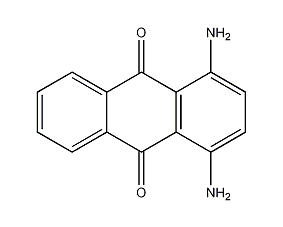
Structural formula
| Business number | 03LU |
|---|---|
| Molecular formula | C14H10N2O2 |
| Molecular weight | 238.25 |
| label |
1,4-diamino-9,10-anthracenedione, 1,4-Diaminoanthraquinone (oxide form), Dunant Purple 2R, Anthraquinone-1,4-diamine, sudan purple, 1,4-Diamino-10-anthracenedione, 1,4-diamino-9,10-anthracenedione, 1,4-Diamino-9,10-anthraquinone, Aromatic nitrogen-containing compounds and their derivatives |
Numbering system
CAS number:128-95-0
MDL number:MFCD00001224
EINECS number:204-922-6
RTECS number:CB6300000
BRN number:2216556
PubChem number:24862847
Physical property data
1. Properties: dark purple crystal (in pyridine) or purple crystal.
2. Melting point (℃): 268
3. Solubility: soluble in benzene, pyridine, nitrobenzene, aniline, slightly soluble in hot acetic acid and ethanol. The solution in concentrated sulfuric acid is almost colorless, and becomes blue-red after adding boric acid.
Toxicological data
1. Skin/eye irritation: Rabbit eye standard Drez eye dye test: 500mg/24H has a slight irritating effect on the eyes.
2. Acute toxicity: Rat oral LD5O: 5790mg/kg
Rat peritoneal LD5O: 250mg/kg
3. Mutagenicity: Salmonella Gene mutation testing system: 100ug/plate
Microbial gene mutation testing system: 12800ug/L
Ecological data
None yet
Molecular structure data
1. Molar refractive index: 67.14
2. Molar volume (cm3/mol): 163.6
3. Isotonic specific volume (90.2K ): 490.7
4. Surface tension (dyne/cm): 80.9
5. Polarizability (10-24cm3): 26.61
Compute chemical data
1. Reference value for hydrophobic parameter calculation (XlogP): 2.6
2. Number of hydrogen bond donors: 2
3. Number of hydrogen bond acceptors: 4
4. Number of rotatable chemical bonds: 0
5. Number of tautomers: 8
6. Topological molecule polar surface area 86.2
7. Number of heavy atoms: 18
8. Surface charge: 0
9. Complexity: 346
10. Number of isotope atoms: 0
11. Determine the number of atomic stereocenters: 0
12. Uncertain number of atomic stereocenters: 0
13. Determine the number of chemical bond stereocenters: 0
14. Number of uncertain chemical bond stereocenters: 0
15. Number of covalent bond units: 1
Properties and stability
1.Basic properties
Dark purple needle-like crystals. Melting point 268℃. Soluble in ethanol, benzene and nitrobenzene, slightly soluble in water and hot acetic acid.
2.�Body LD1~2g/kg. Rats were intraperitoneally injected with LD100500mg/kg. See 1,5-diaminanthraquinone.
Storage method
Packed in iron drums lined with plastic bags, net weight per drum is 50kg. Store in a ventilated place, protected from sun and moisture.
Synthesis method
Brief description of the production method
1,4-dihydroxyanthraquinone is obtained by condensation of hydroquinone and phthalic anhydride, and then ammoniated to obtain 1,4-diaminoanthraquinone leuco body, which is then oxidized with fuming sulfuric acid. Raw material consumption quota: phthalic anhydride 2131kg/t, hydroquinone 887kg/t, ammonia (20%) 10788kg/t, oleum 3580kg/t.

Purpose
Mainly used to prepare anthraquinone series vat dyes, disperse dyes, acid dyes, etc., such as vat olive R, vat brown BR, disperse violet H-FRL, disperse emerald blue H-GL and other dyes. It can be used by itself as a disperse violet dye.

 微信扫一扫打赏
微信扫一扫打赏

